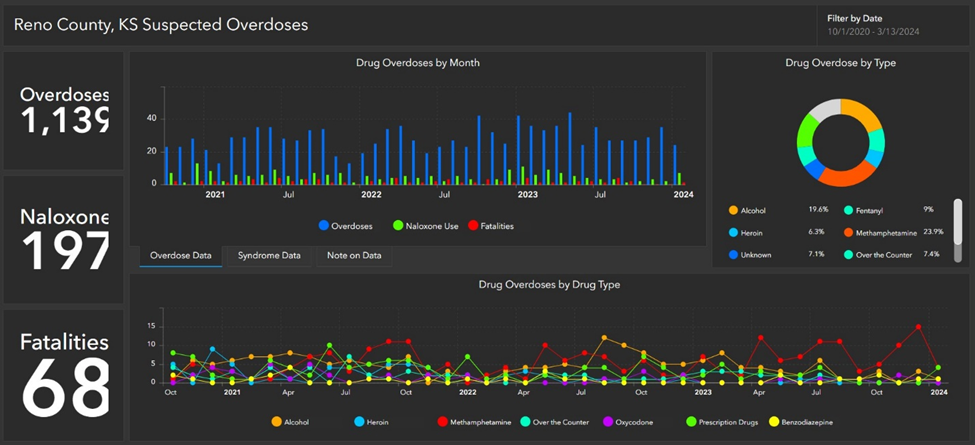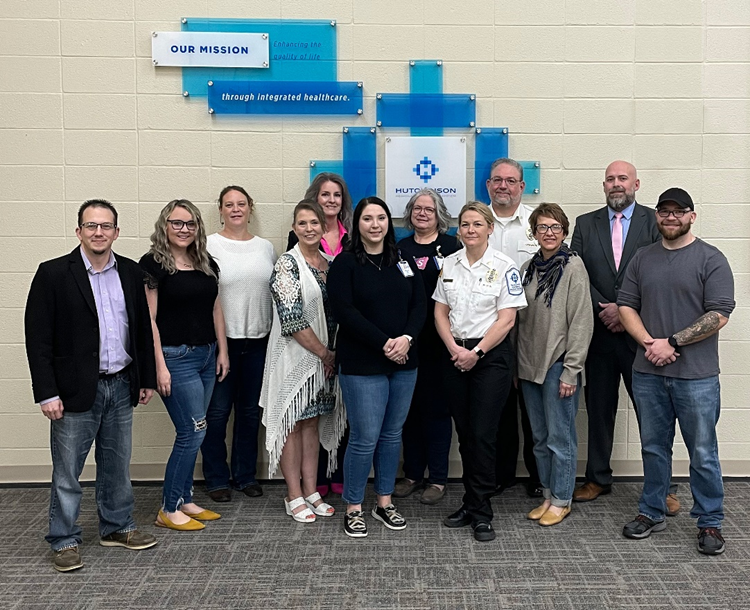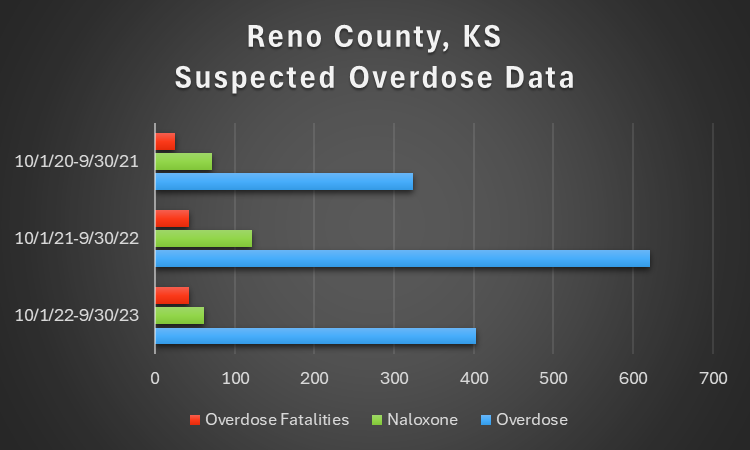
More than one million people have died since 1999 from a drug overdose.1 In 2021, 106,699 drug overdose deaths occurred in the United States. The age-adjusted rate of overdose deaths increased by 14% from 2020 (28.3 per 100,000) to 2021 (32.4 per 100,000).
- Opioids—mainly synthetic opioids (other than methadone)—are currently the main driver of drug overdose deaths. Nearly 88% of opioid-involved overdose deaths involved synthetic opioids.
- Opioids were involved in 80,411 overdose deaths in 2021 (75.4% of all drug overdose deaths).
- Drug overdose deaths involving psychostimulants such as methamphetamine are increasing with and without synthetic opioid involvement.2
Hutchinson Regional Healthcare System is a locally owned and governed community hospital system located in Hutchinson, KS, serving Reno County, KS and the surrounding area. More than 40 years ago a group of visionary leaders made history when they successfully combined two competing hospitals into one united entity that could serve all the healthcare needs of the area. In 1975, the merger was one of the first of its kind in the nation. 3 Today, Hutchinson Regional Healthcare System continues to demonstrate vision and willingness to collaborate to solve the issues that face their health system and the community they serve.
Hutchinson, the 11th largest city in Kansas, shares characteristics of both urban and rural communities yet faces some unique challenges. Hutchinson has three state prison facilities (minimum, medium, and maximum security) that provide steady employment for many but draws several transient families to the area who need a variety of social services. 4
Reno County is not unlike many communities across the United States in that they have seen an increase of Substance Abuse Disorder (SUD) and related harms in recent years. In response to the emergent need to address SUD in the community, the Reno County Drug Task Force was formed but later reorganized and renamed the Reno Recovery Collaborative (RRC). The collaborative consists of Reno County citizens and organizations that are committed to the reduction of harm caused by the substance use epidemic which include Hutchinson Regional Healthcare System, the Reno County Health Department, local law enforcement agencies, SUD and Mental Health treatment providers and facilities, schools and other community stakeholders.
As the RRC worked to address SUD in the community, as with any improvement project, they identified the need for actionable, timely data. In October 2020, the community began to use the Overdose Detection Mapping Application Program (ODMAP) and eventually a Suspected Overdose data dashboard which combines the data derived from ODMAP and Electronic Surveillance System for the Early Notification of Community-Based Epidemics (ESSENCE).
- Reno County Health Department (October 2020)
- Reno County EMS (October 2020)
- Reno County Coroner (January 2021)
- Haven Police Department (November 2021)
- Kansas Board of EMS (February 2022)
-
Hutchinson Regional Medical Center (October 2020)

Source: https://reno.maps.arcgis.com/apps/dashboards/6e5f01c85f524c08b9aea458926f8fdb
The hospital created an Opioid Stewardship Committee which is also attended by members of the RRC. The collaboration between the health care community and the RRC has changed how care is delivered and perceived, by providers, patients and the community. Communication has improved amongst care settings and between SUD community stakeholders. Stigma around SUD and those seeing treatment has improved. Providers and patients have more treatment options with increased SUD treatment beds and types of treatment, access to outpatient Medication Assisted Treatment (MAT) and a mobile methadone clinic.


Source: https://reno.maps.arcgis.com/apps/dashboards/6e5f01c85f524c08b9aea458926f8fdb
Megan Beck, Clinical Quality and Stroke Certification Coordinator and Opioid Stewardship Committee leader at Hutchinson Regional shared that though they have seen an increased number of overdoses over the years, they attribute the increase in part to reduced stigma. More patients and families are dialing 911 and seeking emergency services in the case of an overdose (thus being counted in the community statistics) than in years past. Their community-wide efforts have resulted in a decrease in the percentage of fatal overdoses over time, about two percent so far.
Seth Dewey, Health Educator – Substance Misuse, with the Reno County Health Department and a champion member of the RRC spoke to the reduction of stigma in the community, “Most of the reduction of stigma is measured with qualitative data learned and observed in actual conversations with individuals served and the partners, but the Health Department has quantitative data from the Community Health Assessment where the community was asked about their support of harm reduction and whether they view substance use disorder as a disease or not. Both of those answers surprised us as the majority of answers showed support for harm reduction and viewed SUD as a disease. Both of these are indications of reduction in stigma,” says Dewey.
Renorecoveryks.com is a resource tool created, by the RRC, for the citizens of Reno County. It is designed to help the community overcome the dangers of substance use by providing non-stigmatizing, online digital resources and screening tools for those who may be struggling with substance use as well as easy to access data through the Suspected Overdose Dashboard. 5
Beck reports they still experience challenges when the hospital facilitates patient transfers to rehabilitation services. “It’s still a challenge. We’ve seen services available grow but those needing services has also increased.” She reports that in some cases, the time between referral and assessment is not ideal, but they continue to work to reduce the wait, increase access and improve their processes. “The gaps we’ve been working on for several years are still there and may be for a long time. As healthcare evolves and the standard of care for patients is improved, it will inevitably open more gaps that create areas of opportunities for communities to work on,” says Beck.
It’s a marathon, not a sprint. Progress is slow in terms of what they see in the outcomes data, but that’s not discouraging their efforts to improve patient outcomes. Nicholas Baldetti, Chief Operating Officer at Hutchinson Regional shares, “The Hutchinson Regional Medical Center believes that to ensure the efficacy within the continuum of care for our community as a whole, the assurance of equitable access to that continuum to the recovery community is vital. The Hutchinson Regional Health System continues to proudly be engaged with the Reno Recovery Collaborative to ensure greater capacity to access health care for the recovery community and greater Reno County."
